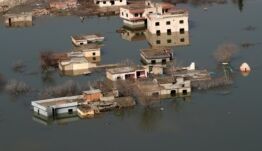正文
‘History Disappears’ as Dam Water Floods Ancient Turkish Town
Every day, hundreds of people gather on the edge of the Tigris River in southeast Turkey. They stand and watch as a 12,000-year-old town slowly disappears.
Rising water levels from the Ilisu Dam are flooding the ancient town of Hasankeyf. Turkish government officials approved plans for the dam in 1997. It was built to produce electricity for the area.
But the effects of the flooding will force out nearly 80,000 people from 199 villages. Even officials in neighboring Iraq are worried. They fear what the project will do to water supplies from the Tigris.
After years of delays, the dam started filling last July. Water levels in and around Hasankeyf have already risen about 15 meters. The levels continue to rise by around 15 centimeters a day.

The dam forms part of Turkey's Southeastern Anatolia Project. The effort is designed to increase economic activity in the poor and underdeveloped area.
Locals have moved out of Hasankeyf. Many of them moved to a new town, Yeni Hasankeyf, on a nearby hill. "Yeni" means "new" in Turkish. The town will sit along a newly created waterway once the dam is completely filled.
For now, locals can still see the stone supports of an ancient bridge that once crossed the Tigris. They also can see a modern-day bridge. But both structures are slowly disappearing.
Dirt has been left at both ends of the modern bridge, which leads into Hasankeyf, to prevent people from entering the town. Village guards wait at the end of it.
The water has come up on the shores of the town near the end of the bridge, swallowing some houses. Parts of roads in the town are also under water.
News reporters were turned away from another entrance to Hasankeyf. Police told them that only locals moving their belongings and people with permission from local officials could enter.
Once the dam is filled, proposed plans for the area include tourist boats that will travel between the new town and a part of the old town that will remain above the water. Several historic structures -- including a massive tomb, an ancient Turkish bath and an historic Islamic center -- have already been moved to Yeni Hasankeyf.
The Ilisu Dam will produce 1,200 megawatts of electricity, making it Turkey's fourth-largest dam in terms of energy production.
The historic Hasankeyf fortress is where where Romans, Mongols and Seljuk Turks fought or settled centuries ago. Below it, a canyon containing hundreds of caves in which people once lived and worked has been filled with concrete. A waterway was built on top of the hard surface to make rain water flow into the dam.
The dam is now 20 to 25 percent full, reports the Hasankeyf Coordination group. The water will likely rise another 50 meters in coming months, reaching just below the top of the fortress.
‘Dusty beautiful caves'
Eyup Agilday, a 27-year-old shepherd, recently moved to the new town. He still visits the old village each day to take care of his sheep. He left the animals behind because there is no land for farming in the new town.
"When I see Hasankeyf being left under water, I am torn up inside. We have memories there but our history is there as well. We are talking about 12,000 years," Agilday said. He added that around five families were still coming to the town to take care of their animals.
Ramazan Sevik, who is from the nearby village of Gercus, came with his two children to visit the town before it is gone.
"We saw the history here but our children didn't see those dusty beautiful caves. They'll only a see a version of it with make-up," the 45-year-old said.
"Those who opposed (the project) were accused of being political," Sevik said. "Even if you're an environmentalist, a patriot, or animal lover, they labeled you as something else when you said ‘Stop!' to the project."
He added, "Now, we're watching history slowly disappear."
I'm Ashley Thompson.
The Reuters news agency reported this story. Ashley Thompson adapted it for VOA Learning English. George Grow was the editor.
相关文章
- US, Haiti Seek Release of 17 Missionaries Taken by Gang
- Past Ability: Could, Was Able To, Managed To
- Harvest Workers Among COVID World's Last Normal Travelers
- 'The Last Leaf,' by O. Henry
- Part 2: Comparing Equal Amounts with As…As
- 'Paul's Case,' by Willa Cather, Part Two
- Part 1: Making Comparisons with As...As
- 'Paul's Case,' by Willa Cather, Part One
- ‘Bubble’ Cities Might Slowly Reopen Air Travel in Asia
- Dismantling Democracy? Virus Used as Excuse




 手机网站
手机网站